
Goodfellow's tree kangaroo (Dendrolagus matschiei (goodfellowi)). (Photograph by Hope Rutledge)

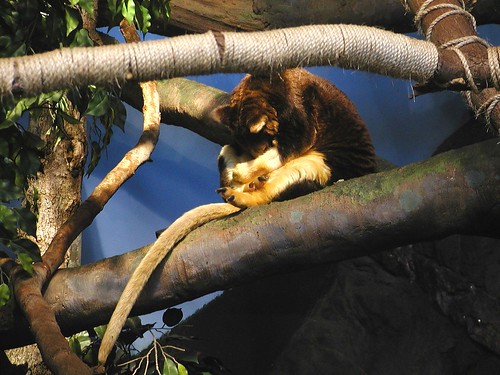
Source;
https://www.eoearth.org/image/Kanga.jpg
http://www.flickr.com/search/?q=Dendrolagus%20matschiei&w=all

Goodfellow's tree kangaroo (Dendrolagus matschiei (goodfellowi)). (Photograph by Hope Rutledge)


Labels: Papua New Guinea
The World Wildlife Fund Scientists have discovered not one, but several new species of orchid species in the forests of Papua New Guinea.
Here is one of their discoveries, Cadetia kutubu, named after the nearby Lake Kutubu.

Source:
http://www.guy-sports.com/humor/pictures/picture_orchid.htm
Labels: Papua New Guinea

Now conservationists have made a discovery that would make any orchid hunter weep with joy - up to 28 new species of the flower. Eight of them are already confirmed as brand new plants that have never been seen before.
Among them is a stunning orchid with a delicate star-shaped flower and another that has bright white petals dabbed with vivid fuschia. The team have also recently found another 20 orchids in the same area and are now busy trying to verify whether these too are newly-discovered species.
Conservationists say the discovery of so many new orchids in the unexplored rainforests of Papua New Guinea is incredibly exciting - especially as around 70 species have recently been wiped out in neighbouring Indonesia.
They are now appealing for renewed efforts to protect the Kikori region where the orchids were found to ensure these flowers and other unique species are not destroyed.
The flowers mark the culmination of a long-term study by the WWF charity going back as far as 1998 of tropical rainforest in the country. Papua New Guinea occupies the eastern half of the tropical island of New Guinea - the other half belonging to Indonesia - which lies to the north of Australia.
Some 85 per cent of the country is covered in tropical rainforest home to a combination of Asian and Australian species including birds of paradise and the extraordinary tree kangaroo. Papua New Guinea is also known to have more recorded species of orchid than any other country in the world.
Wayne Harris, a botanist from Queensland Herbarium and one of the leading experts on orchids said: 'The island of New Guinea is an incredible goldmine of orchids.
'There are over 3,000 known species found here with countless varieties yet to be discovered.'
Olo Gebia a WWF forest ecologist said the finding of the new species was very good news. 'The discovery of such as large number of new species is incredibly exciting,' he said.
He said around 70 species that used to exist in the neighbouring forests of Indonesia have died out because of illegal logging. 'The sad reality is that many of these plants including those which may contain cures to some of the world's most deadly diseases may become extinct before they have even been discovered - this gives even greater urgency to ensuring the long-term conservation of the remarkable Kikori region.'
The WWF is working to help conserve the Kikori region which is home to 20,000 people who rely on the bounties of its forests and streams for their livelihood and food.
Two new Wildlife Management Areas, protecting significant areas of rainforest, are due to be announced in a week's time to help extend the amount of protected land in the country.
Orchids, because of the shape of their petals and tubers, have been connected with sex for 2,000 years and have been used as an aphrodisiac.
In the past their beauty and rarity has prompted hunters to scour the globe for them even risking their lives in the process.
More than one collector has fallen to his death trying to dislodge those growing trees and some have even ventured into landmine-scattered areas of Vietnam to collect rare orchids.
In his 1939 book, Orchid Hunters, Norman Macdonald wrote: 'When a man falls in love with orchids, he'll do anything to possess the one he wants.
'It's like chasing a green-eyed woman or taking cocaine...It's a sort of madness.'
Source:
http://www.thisislondon.co.uk/news/article-23370896-details/New+Orchid+species+discovered+in+rain+forest/article.do
Labels: Papua New Guinea

Scientists working with the conservation group WWF have discovered stunning orchid species in the forests of Papua New Guinea. They say eight are definitely new species, and a further 20-odd may prove to be new to science as well.
The discoveries include the succulent bloom of Cadetia kutubu, named after Lake Kutubu in its home region.

Papua New Guinea is incredibly rich in orchids. Of some 25,000 species known worldwide, 3,000 come from PNG.
This delicate star-like specimen, a new and as yet un-named species of Taeniophyllum, adds one more to the list.

This new find is a member of the Dendrobium family (D. cuthbertsonii), most of which are epiphytic, living on trees rather than on the ground.
Breeders have created many articial varieties of Dendrobium, including kimilsungia, named after the former North Korean leader.

The colours are gorgeous, the structure awesome; did the best Venetian glass-blowers ever conjure anything as delicate as Dendrobium spectabile?
The name says it all.

The orchid family boasts many of the most outrageously showy blooms in the plant kingdom; and Bulbophyllum masdevalliaceum has all the family traits.
More than 1,800 Bulbophyllum species have been described worldwide, but PNG is their "evolutionary homeland", containing one third of known species.

As well as orchids such as this un-named Cadetia species, new mammals, fish, and insects turn up regularly in the region.
But many species have probably been wiped out by deforestation and human encroachment before they could be described.
WWF and its partners are working with the PNG authorities to protect important conservation areas.
Source:
http://news.bbc.co.uk/2/shared/spl/hi/pop_ups/06/sci_nat_orchid_spectacular/html/8.stm
Labels: Papua New Guinea
Scientists from the conservation nonprofit WWF discovered at least eight new species of orchid while surveying previously unexplored forests in the Kikori region on the southern coast of New Guinea’s principal island.
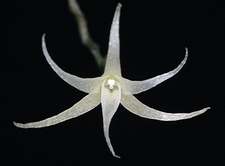
Over the course of three expeditions, the scientists collected some 300 orchid species, 8 of which have been confirmed as new to science, with 20 more still awaiting verification as new varieties.
“There are over 3,000 known species found here with countless varieties undoubtedly yet to be discovered.”
Read the full article and find more photos at National Geographic.com.
Labels: Papua New Guinea
GLAND, Switzerland, October 16, 2006 (ENS) - At least eight new species of orchid have been discovered in tropical rainforests of Papua New Guinea, the international conservation group WWF announced today. The group is awaiting verifcation on as many as 20 other potentionally new orchids, which were found in previously unexplored parts of the Kikori region surrounding Lake Kutubu, an area internationally recognized as a biodiversity hotspot.
"The island of New Guinea is an incredible goldmine of orchids," says Wayne Harris, a botanist from Queensland Herbarium and one of the world's leading authorities on orchids. "There are over 3,000 known species found here with countless varieties undoubtedly yet to be discovered."

The findings mark the culmination of a long-term WWF study of the species within the Kikori region. The expeditions, which took place between 1998 and 2006, have added significantly to the known floral diversity found on the island of New Guinea.
The region is one of the last areas in Papua New Guinea that includes a marked variety of different forest habitats. Along with orchid and other plant-life, the forests are home to a wealth of bird species, including birds of paradise and giant cassowaries, as well as rare fish, mammals and lizards.
Papua New Guinea already has more recorded orchid species than any other country in the world. The discoveries come amid evidence that the world continues to lose animal and plant species - including orchids.
Some 70 species of orchid that used to exist in the forests of neighboring Indonesia have become extinct because of illegal logging, said WWF forest ecologist Olo Gebia.

"The discovery of such a large number of new orchid species is incredibly exciting," Gebia said. "The sad reality is that many of these plants, including those which may contain cures to some of the world's most deadly diseases, may become extinct before they have even been discovered - this gives even greater urgency to ensuring the long-term conservation of the remarkable Kikori region."
The announcement comes just a week ahead of the official launch of two new Wildlife Management Areas, protecting significant areas of rainforest where these orchids have been found. The establishment of these Wildlife Management Areas is an important milestone in the program to strengthen the system of protected areas in PNG.
WWF, together with the Kutubu Joint Venture Partnership, is working towards the long-term conservation of the Kikori region and the remarkable diversity of plants and animals that it supports.
In addition to remarkable diversity in plant and animal species, the small island is also a center of cultural diversity. More than 20,000 people, from twelve different ethnic groups, live in the area and rely on the natural resources of its forests and streams for their subsistence livelihood.
The discovery of the new orchid comes in the wake of several other announcements of new species. Last week conservationist described a new bird found in northern Colombia. Last month researchers announced 52 new marine species had been found off the coast of the Indonesian island of Papua - a new bird was also found in northeastern India, the first new bird species found in that country in more than half a century.
Source:
http://www.ens-newswire.com/ens/oct2006/2006-10-16-01.asp
Labels: Papua New Guinea
| Photos of newly discovered species in Brazil's Amazon rainforest mongabay.com September 27, 2006 Brazil has announced the creation of a Amapá State Forest, a 5.7 million acre Amazon protected area larger than the state of New Jersey. According to Conservation International (CI), a conservation group involved with the creation of the state forest, "the designation protects a crucial section of the Amapá Biodiversity Corridor of northern Brazil, which includes some of the most pristine remaining Amazon forest" and is home to some twenty three newly discovered species. |
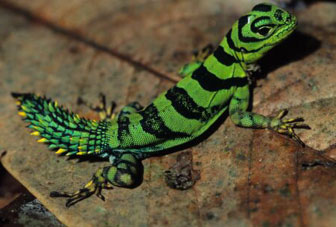 Lizard in the Mountains of Tumucumaque National Park, Amapa, Brazil. Image Credit: Enrico Bernard/CI. 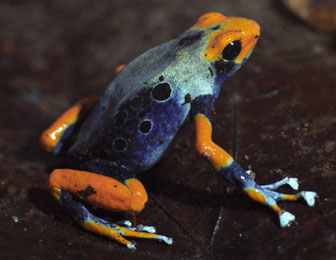 A potential new species of frog of the genus Dendrobates from the Amapa Biodiversity Corridor. Image Credit: Enrico Bernard/CI. |
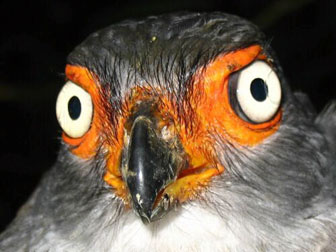 (Micrastur gilvicollis) in the Mountains of Tumucumaque National Park, Amapa, Brazil. Image Credit: Enrico Bernard/CI. 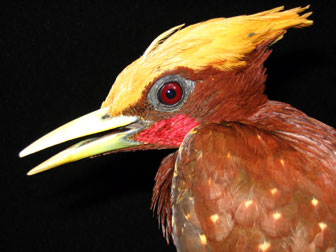 Woodpecker, Mountains of Tumucumaque National Park, Amapa, Brazil. Image Credit: Enrico Bernard/CI. 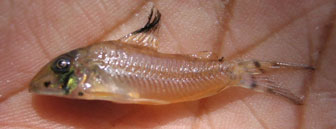 (Corydoras sp), a potential new species from the Amapa Biodiversity Corridor. Image Credit: Cecile de Souza Gama. 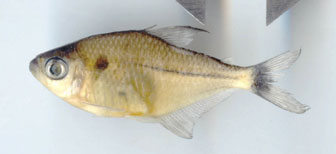 A possible new species from the genus Jupiaba, taken in the Amapa biodiversity corridor. Image Credit: Cecile de Souza Gama. 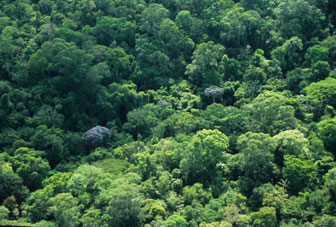 Forest in the Mountains of Tumucumaque National Park, Amapa Biodiverstiy Corridor, Brazil. Image Credit: Enrico Bernard/CI. |
Labels: Brazil

This new species of salamander is one of 3 discovered in an unexplored forest in Costa Rica © A Monro
Three new species of salamander have been discovered in a largely unexplored forest in Costa Rica.
This increases the number of salamander species in Costa Rica from 40 to 43, making the country a centre of diversity for these amphibians.

One of the new species of salamander. It is nocturnal © A Monro
The Natural History Museum led three expeditions to La Amistad National Park on the Costa Rica-Panama border. It is the biggest forest reserve in Central America and yet remains one of the least explored places in the region. The scientists recorded 5,300 plants, insects and amphibians from their trips.
'Finding so many new species in one area is exciting,' says Dr Alex Monro, biodiversity expert at the Natural History Museum and leader of the exploration project. 'Particularly as this is probably the only place in the world you can find these animals.'
'It shows we still have a lot to learn about the variety of wildlife in this region. We have four more expeditions planned this year - who knows what we could find when we go back?'

One of the new species of dwarf salamander © A Monro
Two of the new salamanders are from the Bolitoglossa genus and are nocturnal, coming out at night to feed. The first Bolitoglossa species is 8cm long and black, with a bold red stripe down its back and small yellow markings on its sides.
The second Bolitoglossa species is 6cm long and deep brown in colour with a pale cream underside.
The third salamander is from the Nototriton (dwarf salamander) genus and is a mere 3cm in length, with red-brown colouring and black markings on its sides.
The specimens are not named yet. They will be described and named by scientists at the University of Costa Rica, where they will form part of the national collections.

Cloud forest of La Amistad in Costa Rica. It is the biggest forest reserve in Central America © A Monro
La Amistad is a UNESCO World Heritage Site and it represents the most remote part of the Talamanca Mountains, mainly due to its treacherous terrain and lack of roads.
It has been estimated that two thirds of all Costa Rica's native species live there, including more than 250 species of reptiles and amphibians, 600 species of birds, 215 species of mammals and 14,000 species of plant.
The expeditions are part of a project funded by the UK government's Darwin Initiative to provide baseline information to underpin the conservation of La Amistad National Park.
The Natural History Museum is working in partnership with Costa Rica's national biodiversity institute, INBio, the University of Costa Rica, the University of Panama and Panama's National Parks' Authority.
Source:
http://www.nhm.ac.uk/about-us/news/2008/january/news_13214.html
Labels: Costarica
Article from: AdelaideNow
June 05, 2007 05:00pm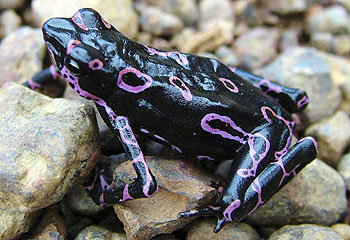
“SCIENTISTS say they have found two dozen new species in an expedition into a remote part of South America.
The Associated Press reported that an expedition by 13 scientists into the remote plateaus of eastern Suriname had turned up 24 new species, including a frog with fluorescent purple markings.
The expedition led by Conservation International discovered the species in 2005 in rainforests and swamps about 130 kilometers southeast of Paramaribo, the capital of the South American country bordering Brazil, Guyana and French Guiana.
Among the newly discovered species were the Atelopus frog, which has distinctive purple markings; six types of fish; 12 dung beetles, and one ant species… “
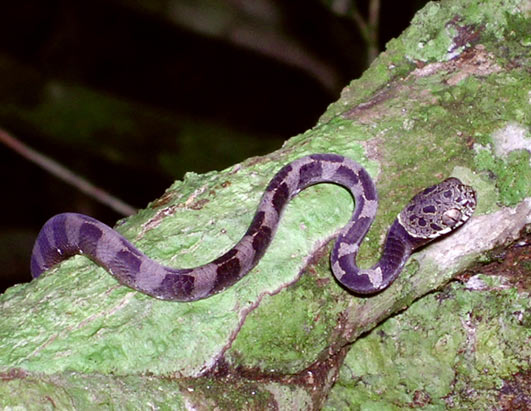
Above: Amazonian Snail-Eater Snake
—–
*Note: Aquarium enthusiasts will be interested in the discovery of several suckermouth catfish- at least 3 new species- one of which has a particularly large mouth, and another that is fond of RED algae… not to mention the appearance of the Armored catfish, which was believed to be extinct.
The original article (above) from AdelaideNow includes several pictures.
The Conservation International website has the full pdf file of the R.A.P. report.
The ABC News website has more pics- also high res.
Telegraph.co.uk has more pics- including some not on the previous sites.
Mongabay.com has a great article with more information.
Labels: Amazon, South America
A new species of hummingbird, the Gorgeted Puffleg, Eriocnemis Isabellaea, has been discovered in the Serrania del Pinche mountains of southwest Colombia.
According to ornithologists, the Gorgeted Puffleg has been discovered living in the cloud forests of southwestern Colombia. Despite its recent discovery, this stunning rare hummingbird that has violet blue plumage and iridescent green on its throat, is already endangered by the environmentally damaging illegal drugs industry."We were essentially following a hunch," said Alexander Cortés-Diago of the Hummingbird Conservancy in Colombia and co-discoverer of Gorgeted Puffleg. "We had heard that a new species of plant had been discovered in the region in 1994. This discovery and the isolation of the Serrania led us to believe there could also be new species of vertebrates."
According to its discoverers, the new species measures between 3.5 inches and four inches in length. The bird gets its unusual name from its enlarged, bicoloured iridescent throat patch (its "gorget") and from the appearance of having "little cotton balls above their legs," said Luis Mazariegos-Hurtado, who has spent 30 years documenting hummingbirds and founded the Colombian Hummingbird Conservancy.
The new species, which was recently given the scientific name, Eriocnemis isabellae, was confirmed by two of the world's leading specialists on the puffleg, Karl L. Schuchmann, curator of ornithology at Zoological Research Museum A. Koenig in Germany, and F. Gary Stiles of the Natural Sciences Institute at the National University of Colombia.
"The description of the species has been published in Ornitologica Neotropical, a well respected peer-reviewed journal," said Greg Butcher, director of bird conservation for the Washington-based National Audubon Society. "The description of the bird in that journal leaves no doubt that it is a very distinctive species, and will be accepted as such by the ornithological community."
The two field ornithologists who discovered the hummingbird saw it three times in 2005 while they conducted field surveys of the mountain cloud forest in the Serrania del Pinche mountains in southwest Colombia. In 2006, they returned to confirm the sighting despite the presence of leftist rebels and drug traffickers in the region. They photographed the birds in 2006, and sent the images to the Zoological Research Museum A. Koenig in Germany for confirmation.
"We immediately suspected the bird as a new species," said Andre Weller of the Brehm Fund for International Bird Conservation/Zoological Research Museum A. Koenig. "Further study has shown that this is certainly the most spectacular discovery of a new hummingbird taxon during the last decade or more."
The mountainous Serrania del Pinche region may hold other new species but their future isn't secure because of slash-and-burn farming by coca farmers in the region. This destructive method of farming, combined with the bird's small range give ornithologists cause for concern that this bird may slip into extinction. Coca is the raw material in cocaine.
"Destruction of habitat is the main threat caused by the migration of coca fields from the Caqueta and Putumayo areas to the Pacific," said Luis Mazariegos-Hurtado of the Hummingbird Conservancy in Colombia. He added that slash-and-burn agriculture is expanding in the area, and this farming technique can cause "dangerous fires that can easily burn a whole mountain."
Researchers are especially worried because the hummingbird has only been sighted on one mountain ridge. Ornithologists are asking the Colombian government to protect this area.
"To go undiscovered for so long, the bird's range must be extremely small and fragile -- hence conservation action is undoubtedly a priority for the Serrania del Pinche," said Ian Davidson of the conservation group Birdlife International.
The Gorgeted Puffleg brings to 15 the number of species in this genus, which are mostly found in Colombia. There are more than 300 species of hummingbirds in the world, nearly half of which live in Colombia. Further, Colombia is a gold mine for bird species, with more than 1,800 total native species.
"This is a discovery with mixed emotions: the indescribable happiness of finding a new hummingbird and the harsh reality that this may be one of the most endangered species outside of an unprotected area." said Luis Alfonso Ortega, co-discoverer of the hummingbird.
Source:
http://scienceblogs.com/grrlscientist/2007/05/new_hummingbird_species_discov.php
Labels: Colombia
by Rich Bowden - Apr 29 2008, 22:14 Photo: This horned toad believed to be new to science of the genus Proceratophrys, was one of 14 new species found by scientists in Brazil. Credit: Conservation International. A research team has discovered up to fourteen new species during an expedition to the remote Cerrado region of Brazil. A legless lizard, a tiny woodpecker along with twelve other species suspected to be new to science were found in the wooded grassland of the Cerrado which once covered a region the size of Europe. However the region, which still covers around 20 percent of Brazil, is now in the process of being turned into cropland and ranchland by farmers with the resulting loss of valuable native vegetation and unique species. “It’s very exciting to find new species and data on the richness, abundance, and distribution of wildlife in one of the most extensive, complex, and unknown regions of the Cerrado,” said Conservation International (CI) biologist Cristiano Nogueira, the expedition leader in a CI statement. “Protected areas such as the Ecological Station are home to some of the last remaining healthy ecosystems in a region increasingly threatened by urban growth and mechanized agriculture.” The scientists say final results of the study which will include the description of the new species, will assist them in structuring future conservation programmes. “The geographic distribution of some of the species registered is restricted to the area of the ecological station; thus their survival depends on the good management of the protected area and its immediate surroundings,” said Luís Fabio Silveira, of the Department of Zoology of the University of São Paulo. “From the survey we can obtain data concerning the anatomy, reproductive biology, life cycle, and distribution of the species, all of which help us in future conservation programs.” “We need to know our protected areas better, especially the ecological stations whose principal objective is to generate scientific knowledge of Brazilian biodiversity, so little studied and already so severely threatened,” Nogueira said. “Unfortunately, extensive areas of the Cerrado, like the Ecological Station, are becoming increasingly rare, thus making the data collected even more important. Above all, it is necessary to know to conserve.” The expedition included 26 researchers from the University of São Paulo and its Museum of Zoology; the federal universities of São Carlos and Tocantins; and CI-Brazil, said the statement. It was funded by the O Boticário Foundation for Conservation of Nature, with the support of the NGO Pequi–Pesquisa e Conservação do CerradoCerrado. Source: http://www.thetechherald.com/article.php/200818/849/Scientists-find-fourteen-new-species-in-Brazil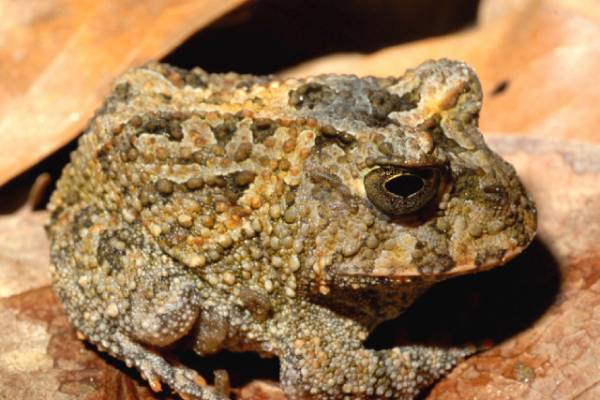
Labels: Brazil

D. new species
Source:
http://www.doweryorchids.com/dendrobium.htm
Labels: Orchid

Loads of new species of exotic fish and corals have been discovered off Papua, New Guinea. The area is known as the Bird's Head Seascape reef

This epaulette shark was one of the exciting new discoveries. Experts say the creatures appear to 'walk' on its fins on the bottom of the sea

This picture shows a Pterocaesio - one of 50 new species found by an expedition by a group called Conservation International

This reef-building coral helps provide shelter and food for many of the creatures. There are thought to be about 600 types of coral living at Bird's Head - about 50% more than on the Great Barrier Reef in Australia

This interesting-looking little fish is a Paracheilinus walton - a new species of flasher wrasse. They get their name from their brightly coloured bodies which appear to 'flash' in the water

And this is called a Cirrhilabrus cenderawasih, another type of flasher wrasse

This bright purple fish is called a Pseudochromis - a previously unknown dottyback. These fish tend to like eating plankton, small crustaceans and worms

And this stripy creatures is called a Meiacanthus. Experts are now calling for the Bird's Head Seascape reef to be protected. This could stop it being damaged by tourists and fishing
Arpita Mukherjee | Nov 7 2007

However, scientists say that more research is necessary to confirm that the species is new. Roosmalen is campaigning for conservation of wild life in the Amazon. He said that the new peccary, which he dubbed Pecari maximus, inhabits a logged frontier of the Amazon around Nova Aripuana where the number of sawmills has grown from two in 2002 to fourteen in the current year.
The wild pig species usually travels in small groups comprising of two adults and one or two off springs. While other species move in large herds, these pigs that travel in small groups are vulnerable to hunters.
Van Roosmalen�s success in discovering new species in the Amazon has earned him international acclaim.
Source:
http://www.greendiary.com/entry/new-pig-species-found-in-amazon/
Labels: Amazon

Labels: India
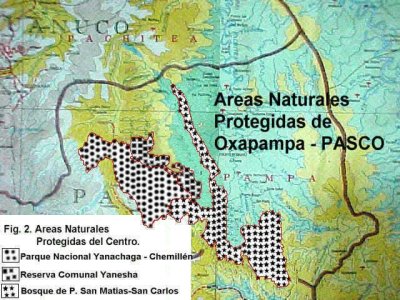 Three Reserves in Oxapampa province | |
| Point cursor on image for full caption | |
The Cordilleras de Yanachaga and San Matias-San Carlos are relatively small mountain ranges on the eastern side of the Andes in the Department of Pasco, central Peru. The town of Villa Rica borders these Cordilleras in the south, the town of Pozuzu in the north; while the road from Oxapampa to Pozuzu along the Rio Huancabamba forms the border on the western edge, and the extensive lowland forests in the Amazonian plains, the eastern boundary. The two Cordilleras are separated by the basins of the Rio Palcazu and the Rio Iscosazin, where the Yanesha Communal Reserve is situated. The altitudinal range in the area is considerable—from about 500 m in the lowlands to the highest peak in the Cordillera de Yanachaga, at 3800 m. Rainfall is plentiful, exceeding 6000 mm in some places, and the entire zone is covered with wet lowland or montane forest, with small patches of high altitude paramo in the summit areas. Temperatures vary with altitude, and the climate ranges from wet tropical in the lowlands to cold and wet in the paramos. Rainfall is spread evenly throughout the year; there is no pronounced dry season, and the vegetation is evergreen, irrespective of the altitude.
Geologically, the oldest formations in the area are on the western border of the Cordillera de Yanachaga and consist of intrusive Permian layers in the northwestern part, Permian deposits along the western edge, and a fairly large area with upper Triassic/lower Jurassic rocks in the north; while most of the remaining parts of the Cordilleras consist of various Cretaceous rocks with a small area of upper Jurassic and one with Quaternary alluvial deposits near the eastern bondary of the Yanachaga National Park. Ore-bearing minerals have not been found in the Park, and consequently there are no mining activities. The Cordilleras de Yanachaga and San Matias-San Carlos are part of what have been called the “sub-Andean cordilleras,” a discontinuous chain of mountain ranges that run parallel to the main Andean chain but attain more modest elevations and are separated from the main Andean chain by low-altitude valleys. The Galera and Cutucu ranges and the Cordillera del Condor in Ecuador and the Cordillera Azul in Peru form part of the sub-Andean cordilleras. The main Andean range is composed mostly of metamorphic and volcanic rocks, while the sub-Andean cordilleras consist mostly of Mesozoic and early Tertiary sediments, such as sandstone and limestone, deposited at the western margin of South America prior to the rise of the Andes.
In 1980 the government of Peru started a development program in the Selva Central, the region between the Cordillera de Yanachaga and the Cordillera de San Matias-San Carlos; this program included the design and development of projects aimed at environmental protection. In 1982 USAID signed an agreement with the government of Peru and became involved in this program with the goals of establishing a National Park in the Cordillera de Yanachaga and a Forest Reserve in the Cordillera de San Matias-San Carlos. During the second half of the 1980s the Peruvian government created three protected areas in this region: the Yanachaga-Chemillen National Park (1222 km2) was established in 1986; the San Matias-San Carlos Protected Forest (1458 km2) in 1987; and the Yanesha Communal Reserve (347 km2) in 1988. These three protected areas are contiguous and cover almost 3000 km2. Currently, a plan to create a Biosphere Reserve consisting of the three protected areas, possibly augmented with the headwaters of the Rio Pachitea, is being discussed, but no decision has been taken yet. The project is aimed at making a botanical inventory of the three protected areas based on extensive collecting efforts and study of earlier collections.
Source:
http://www.mobot.org/mobot/research/peru/three-reserves-in-oxapampa.shtml
Labels: Peru

The tiger huntsman is believed to be a new species.
Photo: Alan Henderson
The distinctive spider, dubbed the tiger huntsman for its orange and black markings, was found by museum staff on a collecting trip to north Queensland.
Live exhibits co-ordinator and self-confessed spider nut Alan Henderson said he knew he was on to something special when he spotted the spider in a rainforest outside Cairns.
"I've always been excited about spiders, but to see something that I've never ever seen before and never even seen a photograph of is pretty exciting," Mr Henderson said. "Up until that moment I didn't think anything that colourful existed in Australia."
After the team returned to Melbourne, photographs of the female huntsman — which has a 35-millimetre body and a legspan of about 90 millimetres — were sent to spider experts around the country, but none recognised it.
But confirmation it is a new species of huntsman will not be possible until it dies and scientists can examine it under a microscope.
The huntsman lives for about two years, and this one is believed to be about a year old. It feasts on live crickets and cockroaches.
It was added this month to the museum's Bugs Alive! exhibit, where it can show off what Mr Henderson describes as excellent climbing and jumping skills.
"Once she jumped and then in mid-air turned and landed on the opposing surface," he said. "I held up the 10-card for that."
Source:Labels: Australia
 The Bird of Paradise is one of the rarest birds in the world found in Papua New Guinea. It is very elusive and make it's habitat up in the highlands far away from villagers. (Best viewed large)
The Bird of Paradise is one of the rarest birds in the world found in Papua New Guinea. It is very elusive and make it's habitat up in the highlands far away from villagers. (Best viewed large)
Alec Ee
Source:
http://photo.net/photodb/photo?photo_id=2271187&size=lg
Labels: Papua New Guinea
Discovery Species - Zona Cerebral | WP Premium Blogger Template | Original WP Premium theme by WP Remix
Copyright 2008. R.Bhavesh. All rights reserved